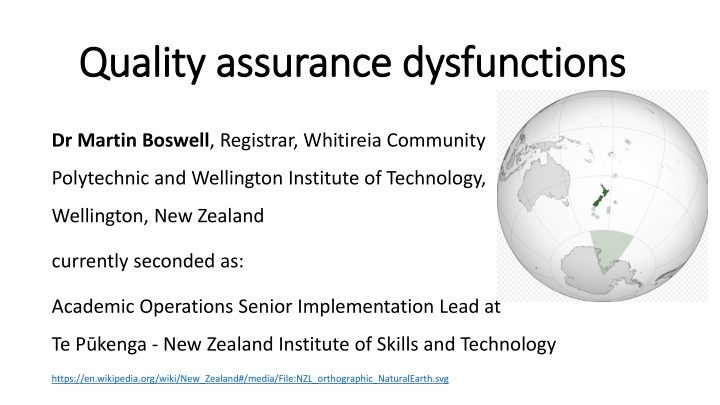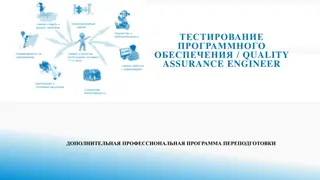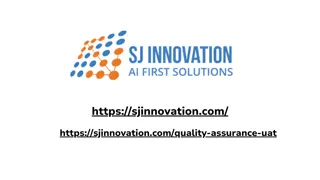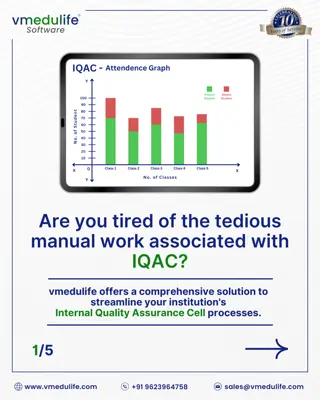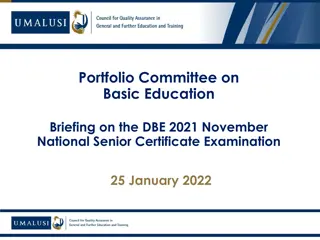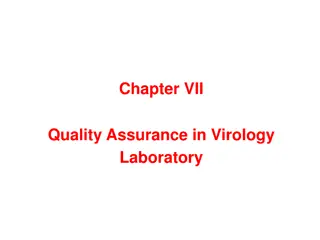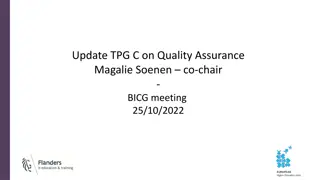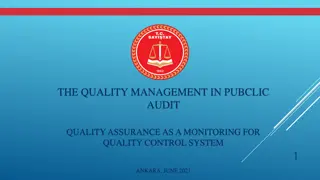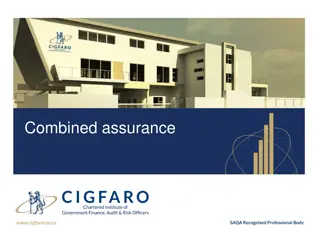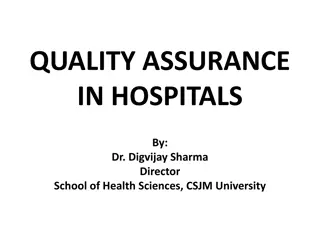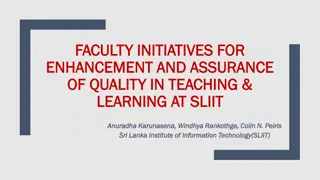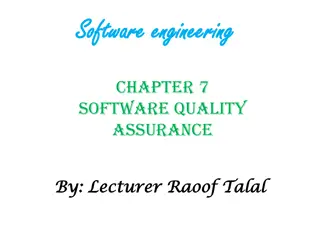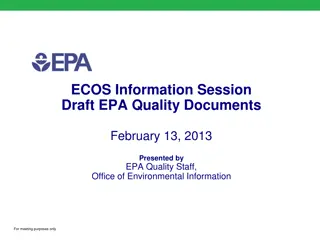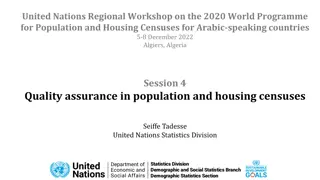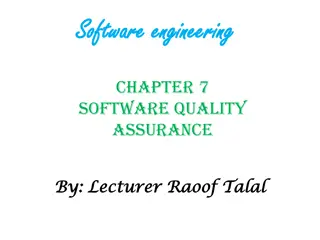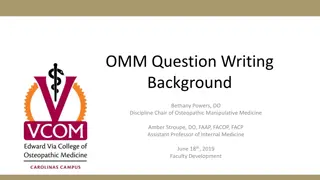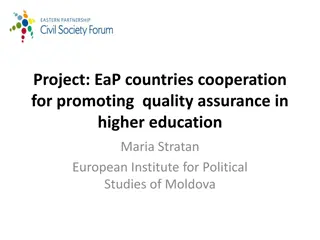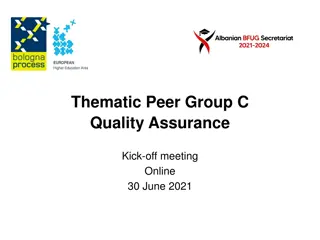Quality assurance dysfunctions
This content discusses quality assurance dysfunctions in academic institutions, focusing on an external QA process in New Zealand operated by the Academic Quality Agency for New Zealand Universities. It includes a case study on academic audits, engagement with quality assurance, and summary findings on dysfunctions such as good intentions, reinterpretation, deferral, and repackaging. Recommendations for improvement are highlighted to address potential challenges in implementing quality assurance processes effectively.
Download Presentation

Please find below an Image/Link to download the presentation.
The content on the website is provided AS IS for your information and personal use only. It may not be sold, licensed, or shared on other websites without obtaining consent from the author.If you encounter any issues during the download, it is possible that the publisher has removed the file from their server.
You are allowed to download the files provided on this website for personal or commercial use, subject to the condition that they are used lawfully. All files are the property of their respective owners.
The content on the website is provided AS IS for your information and personal use only. It may not be sold, licensed, or shared on other websites without obtaining consent from the author.
E N D
Presentation Transcript
Quality assurance dysfunctions Quality assurance dysfunctions Dr Martin Boswell, Registrar, Whitireia Community Polytechnic and Wellington Institute of Technology, Wellington, New Zealand currently seconded as: Academic Operations Senior Implementation Lead at Te P kenga - New Zealand Institute of Skills and Technology https://en.wikipedia.org/wiki/New_Zealand#/media/File:NZL_orthographic_NaturalEarth.svg
Academic audit Academic audit a case study from New Zealand a case study from New Zealand An external QA process conducted in NZ since 1994 1. Operated by non-government agency: the Academic Quality Agency for New Zealand Universities (www.aqa.ac.nz) 2. Aims to assure and enhance quality 3. Focus on internal QA processes (not outcomes) 4. Institution level (not programmes) 5. Peer review 6. Recommendations but no pass/fail judgement(s)
PhD: Qualitative, longitudinal case PhD: Qualitative, longitudinal case- -study study Engagement with academic audit, 1994 2019 Methodology: documentary evidence, 19 interviews 11 recommendations recurred Recurrence: potential challenges with engagement and implementation of recommendations 1. Closing the student feedback loop 2. Monitoring PhD student progress (six-monthly reports) 3. QA infrastructure and leadership Supervisors: Prof Stephen Marshall, A/Prof Kate Thornton
Summary findings: QA dysfunctions Part 1 Summary findings: QA dysfunctions Part 1 Good intentions Reinterpretation Deferral Repackaging Institution side: Some quotes used in this presentation have been paraphrased for clarity/brevity
Good intentions Good intentions Background: The AQA encourages enhancement initiatives in self-review process Cycle 3 self-review (2005): The university will conduct a major planning exercise that will re-think QA, including the roles, responsibilities and membership of Academic Board, Academic Committee and Quality Office Cycle 4 audit (2009): Modest changes to Academic Board structure and membership; no other changes Conclusion: Avoid overpromising (institution)
Reinterpretation Reinterpretation Cycle 5 audit (2014): Urgently incorporate feedback to students regarding actions taken in response to course evaluations Cycle 5 mid-cycle report-back (2019): Recommendation has been implemented and timeliness of evaluation of course feedback has improved In fact: no implementation; timeliness not relevant Conclusions: Be truthful (institution). Be attentive (agency)
Deferral Deferral Cycle 2 audit (2000): Recommendation: Create a compendium of QA processes Cycle 3 self-review (2005): We reviewed key issues raised in the report and will start [sic] a review Nothing about compendium of QA processes Symptoms: Actions are ongoing or working group formed Conclusion: Be attentive (agency), lest deferral by institution become a permanent state
Repackaging Repackaging Cycle 2 audit (2000): Close the student feedback loop Cycle 3 audit (2005): Close the student feedback loop Cycle 4 self-review (2009): Enhancement initiative: We will establish [sic] a systematic process for responding to student feedback Recommendation not implemented, now repackaged Conclusion: Be attentive (agency) and challenge failure to implement
Summary findings: QA dysfunctions Part 2 Summary findings: QA dysfunctions Part 2 Echoing Reinforcement Complexity Superimposition Abandonment Quality agency side:
Echoing Echoing Cycle 2 self-review (2000): We were advised to strongly encourage/require staff to provide feedback about survey results to students and explain how their concerns will be addressed Cycle 2 audit (2000): Teachers should be strongly encouraged/ required to provide feedback to students about the results of evaluations and notify how any concerns will be addressed Symptoms: The panel was told that [verbatim quote from self- review] or The university intends to [ditto] Conclusion: Echoing is an indicator of possible superficiality
Reinforcement Reinforcement Cycle 3 audit (2005): The panel was pleased to hear that a new Learning and Teaching Committee will be established and urges that this be done as quickly as possible A suggestion, not a formal recommendation Echoing is observational / Reinforcement implies action Conclusion: If a recommendation is needed, make one. Suggestions are less likely to be implemented if they are buried in the document text.
Complexity: Complexity: An example of 1 recommendation: The panel recommends that the University continues to develop and implement an appropriate institution-wide quality assurance infrastructure and institutional leadership for quality assurance and quality enhancement activities that: 1. builds on and enhances those existing mechanisms and procedures that are effective in supporting a quality culture, 2. facilitates ownership of, and engagement with, quality and continuous improvement activities by the whole University community, and 3. provides assurance of institution-wide quality in research, teaching, learning and community engagement (Cy4AR, 2009, p. 31)
Superimposition Superimposition Cycle 2 audit (2000): (1) Centralize the checking of PhD student biannual progress monitoring and (2) analyse progress monitoring for possible systemic issues Research found only 1 instance (in 19 years) of a systemic issue that was not of a personal nature Why collect and address personal issues systemically? Conclusion: Did the agency create extra bureaucracy? Postscript: The university did not collate personal information; it disobeyed the recommendation
Abandonment Abandonment Cycle 5 audit report (2014): The use of student feedback has been reviewed but there is still a significant agenda for change in teaching and learning Cycle 5 follow-up report (2016): No comment from agency about lack of implementation Cycle 5 mid-cycle report (2019): No comment from agency about lack of implementation Conclusion: Why bother giving the recommendation?
Overall conclusions Overall conclusions Auditors / evaluators must be experienced A longitudinal approach can detect dysfunctions Recommendations must be workable, concise, clear Encourage candour about implementation challenges Agency should not abandon earlier recommendations Targeted QA scope may help avoid superficiality Hierarchical structures seem to hinder quality/QA Carefully consider potential superimposition
Thank you / ! Questions? Thesis: https://doi.org/10.26686/wgtn.22337005
